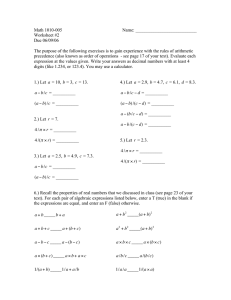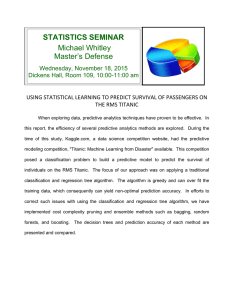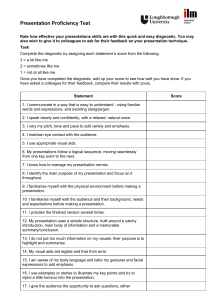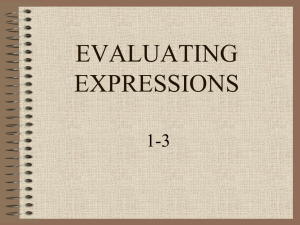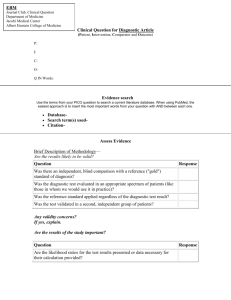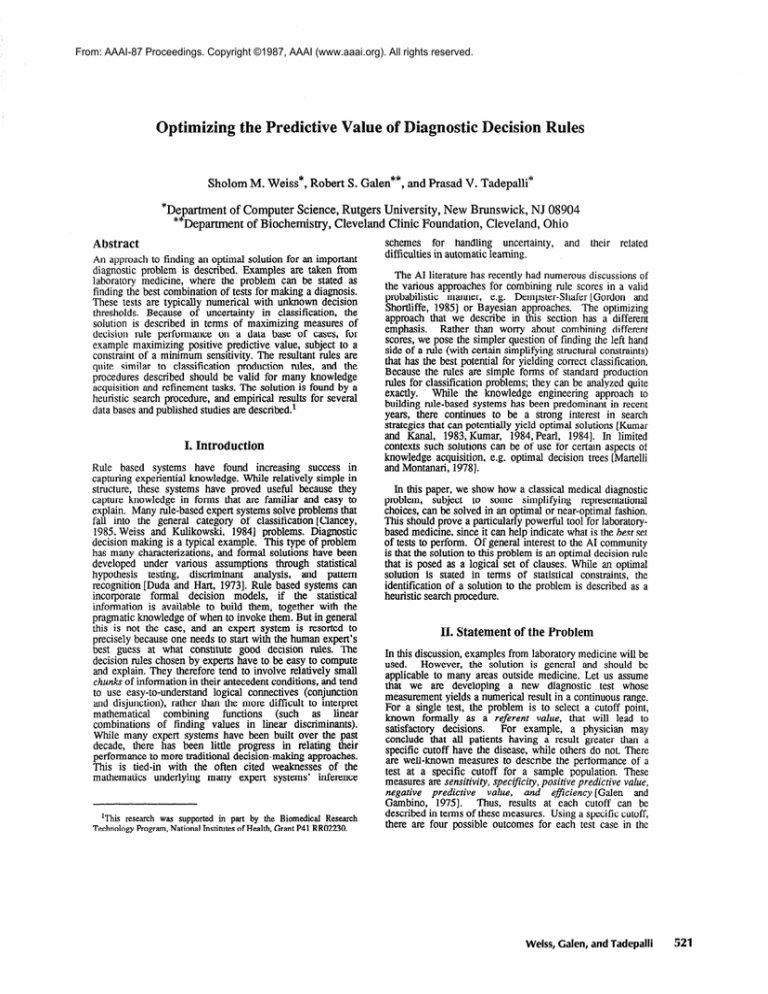
From: AAAI-87 Proceedings. Copyright ©1987, AAAI (www.aaai.org). All rights reserved.
Optimizing the Predictive Value of
Sholom M. Weiss*, Robert S. Galen**, and Prasad V. Tadepalli*
*Dzgartment of Computer Science, Rutgers University, New Brunswick, NJ 08904
Department of Biochemistry, Cleveland Clinic Foundation, Cleveland, Ohio
Abstract
An approach to finding an optimal solution for an important
diagnostic problem is described. Examples are taken from
laboratory medicine, where the problem can be stated as
finding the best combination of tests for making a diagnosis.
These tests are typically numerical with unknown decision
thresholds. Because of uncertainty in classification, the
solution is described in terms of maximizing measures of
decision rule performance on a data base of cases, for
example maximizing positive predictive value, subject to a
constraint of a minimum sensitivity. The resultant rules are
quite similar to classification production rules, and the
procedures described should be valid for many knowledge
acquisition and refinement tasks. The solution is found by a
heuristic search procedure, and empirical results for several
data bases and published studies are described.’
1. Introduction
Rule based systems have found increasing success in
capturing experiential knowledge. While relatively simple in
structure, these systems have proved useful because they
capture knowledge in forms that are familiar and easy to
explain. Many rule-based expert systems solve problems that
fall into the general category of classification [Clancey,
1985, Weiss and Kulikowski, 19841 problems. Diagnostic
decision making is a typical example. This type of problem
has many characterizations, and formal solutions have been
developed under various assumptions through statistical
hypothesis testing, discriminant
analysis, and pattern
recognition [Duda and Hart, 19731. Rule based systems can
incorporate formal decision models, if the statistical
information is available to build them, together with the
pragmatic knowledge of when to invoke them. But in general
this is not the case, and an expert system is resorted to
precisely because one needs to start with the human expert’s
best guess at what constitute good decision rules. The
decision rules chosen by experts have to be easy to compute
and explain. They therefore tend to involve relatively small
chunk of information in their antecedent conditions, and tend
to use easy-to-understand logical connectives (conjunction
and disjunction), rather than the more difficult to interpret
mathematical
combing
functions
(such as linear
combinations of finding values in linear discriminants).
While many expert systems have been built over the past
decade, there has been little progress in relating their
performance to more traditional decision-making approaches.
This is tied-in with the often cited weaknesses of the
mathematics underlying many expert systems’ inference
‘This research was supported in part by the Biomedical Research
Technology Program, National Institutes of Health, Grant P41 RR02230.
schemes for handling uncertainty,
difficulties in automatic learning.
and
their
related
The AI literature has recently had numerous discussions of
the various approaches for combining rule scores in a valid
probabilistic manner, e.g. Dempster-Shafer [Gordon and
ShortIiffe, 19851 or Bayesian approaches. The optimizing
approach that we describe in this section has a different
emphasis.
Rather than worry about combining different
scores, we pose the simpler question of finding the left hand
side of a rule (with certain simplifying structural constraints)
that has the best potential for yielding correct classification.
Because the rules are simple forms of standard production
rules for classification problems; they can be analyzed quite
exactly.
While the knowledge engineering approach to
building rule-based systems has been predominant in recent
years, there continues to be a strong interest in search
strategies that can potentially yield optimal solutions [Kumar
and Kanal, 1983, Kumar, 1984,Pearl. 19841. In limited
contexts such solutions can be of use for certain aspects of
knowledge acquisition, e.g. optimal decision trees [Martelli
and Montanari, 19781.
In this paper, we show how a classical medical diagnostic
problem, subject to some simplifying representational
choices, can be solved in an optimal or near-optimal fashion.
This should prove a particularly powerful tool for laboratorybased medicine, since it can help indicate what is the best set
of tests to perform. Of general interest to the AI community
is that the solution to this problem is an optimal decision rule
that is posed as a logical set of clauses. While an optimal
solution is stated in terms of statistical constraints, the
identification of a solution to the problem is described as a
heuristic search procedure.
II. Statement
of the Problem
In this discussion, examples from laboratory medicine will be
used.
However, the solution is general and should be
applicable to many areas outside medicine. Let us assume
that we are developing a new diagnostic test whose
measurement yields a numerical result in a continuous range.
For a single test, the problem is to select a cutoff point,
known formally as a referent value, that will lead to
satisfactory decisions.
For example, a physician may
conclude that all patients having a result greater than a
specific cutoff have the disease, while others do not. There
are well-known measures to describe the performance of a
test at a specific cutoff for a sample population. These
measures are sensitivity, specificity, positive predictive value,
negative predictive
value, and efficiency [Galen and
Gambino, 19751. Thus, results at each cutoff can be
described in terms of these measures. Using a specific cutoff,
there are four possible outcomes for each test case in the
Weiss, Calen, and Tadepalli
521
sample.2 This is illustrated in Figure 1.
1 Test Positive
1Hypothesis Positive 1True Positives
Hypothesis Negative False Positives
Figureyl:
1 Test Negative
1False Negatives 1
True Negatives
Possible Outcomes of Tests for Hypotheses
Figure 2 formally describes these measures of performance.
In summary, for a single test with a given cutoff and the
application of an arithmetic operator,4 these five measures
can be determined for a population.
The problem of
determining an optimal cutoff can be described as
maximizing one of these measures subject to specific
constraints on the other measures.5
Constraints are the
minimum required values for sensitivity, specificity,
predictive values, and efficiency.6
Finding the optimum
cutoff for WI3C can be posed in the form illustrated in Figure
4.
MAXWWBNG Predictivevalue (+) of WBC
The constraintsare given below:
I Sensitivity
ITP/H+
1Specificity
(TN/HI Predictive value (+) I TP / T+
I
I
I Predictive value (-> I TN / T[Ffficiency
Figure 2: Formal Measures of Diagnostic Performance
While all of these measures have their purpose, the one that
is typically most valuable for rule-based systems is the
positive predictive value. Positive predictive value measures
how often a decision is correct when a test result is positive.
Thus one may use a positive test that has high predictive
value in rules that confirm a diagnosis, and apply different
tests when the result is negative. Many rule based systems
may be thought of as collections of rules with very high
positive predictive values.3 We illustrate these points by
describing data taken from a published study on the
assessment of 8 laboratory tests to confirm the diagnosis of
acute appendicitis for patients admitted to an emergency
room
with
tentative
diagnosis
of
acute
appendicitis [Ma&and, Van Lente, and Galen, 19831. In the
example of Figure 3, the white blood cell count (WI3C) is
used as the test.
Sensitivity
Specificity
Predictive value (-)
Efficiency
2 100.00%
2 0.00%
2 0.00%
z 0.00%
Figure 4: Example of Problem Constraintsfor a Single Test
We note that this problem can be seen as a special
restriction on a statistical decision-making
or pattern
recognition problem. Here the cutoff threshold is not given
and instead must be determined.
For known population
statistics, the threshold for each of these measures that
corresponds to the optimal likelihood ratio choice might be
determined. However, in diagnostic testing, it is rare that
population statistics for large numbers of combinations of
tests can be established. Our form of analysis then answers
questions of optimal diagnostic performance on an empirical
basis, for a particular sample of cases.
Referent value analysis, or cutoff selection, is commonly
done for single tests. We have developed procedures that
allow for the possibility of choosing the set of constraints and
maximizing the remaining measure not only for one or two,
but for a larger number of tests.7 When more than one test is
specified, combinations are formed by using logical AND or
OR operators. We formulate the problem as finding the
optimal combination of tests that will satisfy the given
constraints for the data base. An additional constraint is
added to the problem, in that the length of the expression is
limited by a chosen threshold.8
In Figure 5 using the
appendicitis data base, the problem is to find an optimal
solution in the form of a logical expression whose length is
9hese operators are less than or greater than.
‘Sensitivity and specificity move continuously in opposite directions.
For example, a 100% sensitivitycutoff with 0% specificity can always be
found by classifying every sample as having the hypothesis. Predictive
values have no such relationshipand vary all over the place.
?he
interrelations among these performance parameters, limit the
possiblepatternsof constraintsfor any given set of data.
Figure 3: Example of the 5 Measures of Performance for WE4C>10000
2For purposes of this discussion, we are eliminating the possibility of
unknowns.
3Thisminimizes the effect of an unknownprevalence.
522
Machine learning & Knowledge Acquisition
71f two tests have the same value for the optimized measure, then its
conjugate measure is used to decide which test is better. Sensitivity and
specificity are treated as conjugates to one another and so are positive and
negative predictive values. When optimizing efficiency, positive predictive
value is chosen to be the next decisive function.
‘This sets a limit on the number of tests that may be used in the decision
rule. Some tests may be also deliberately excluded from considerationand
some tests may be designatedas mandatory. This allows for furtherpruning
of the search space.
no greater than 3 tests9
MAXMUING
Predictive value (+)
where Bi is the ith Bell number.13
The constraints are given below:
Sensitivity
Specificity
Predictive value (-)
Efficiency
Number of terms
5 100.00%
r
0.00%
2 0.00%
z 0.00%
3
I
I
Figure 5: Example of Problem Constraints for 3 or Fewer Tests
At this point we note that the rules are just like many found
in typical classification
expert systems, since, like
productions, they are described as logical combinations of
findings that are not mutually exclusive.1° Thus, they have
the intuitive appeal in explaining decisions because of their
modular nature, while being supported empirically by their
performance over the data base. In contrast to traditional
machine learning [Mitchell, 1982, Quinlan, 1986, Michalski,
Mozetic, Hong, and Lavrac, 19861, the objective here is to
find the single best conjunctive or disjunctive rule of a fixed
size. Starting with undetermined cutoffs for continuous
variables, these rules classify under conditions of uncertainty,
where two types of classification errors, false positives and
false negatives, need not be considered of equal importance.
III. Complexity
In Section II, we described the problem as finding the best
logical expression of a fixed length or less that covers a
sample population. In this section, we consider the
complexity of exhaustively generating and testing all
possibilities. Except for relatively small populations or
numbers of tests,ll
the exhaustive approach is not
computationally feasible.
Equation 1 is the number of expressions having only
ANDs; Equation 2 is for expressions having either ANDs or
ORs. In these equations, n is the number of tests, k is is the
maximum number of tests in the expression, c is the number
of constants (cutoff values) to be examined for each test, and
ci is c raised to the ith power. While the number of distinct
values that must be examined for each test may vary, we have
have used a fixed number, c, to simplify the notation and
analysis.
In Equation 2, expressions are generated in
disjunctive normal form. l2
ci
The most computationally
expensive
(exponential)
component of Equation 2 component is ci. It is possible to
devise exhaustive procedures that do not require the
examination of every value of a test found in the data base.
For each test, one may examine only those points that overlap
in the H+ and H- populations. Moreover, only the smaller set
of the two sets of points in the overlapping zone need be
candidates for cutoffs.14 Even taking this into account,
relatively small values of c will make the computation
prohibitive.
(1)
Because one may allow for the repetition of a test in an
expression, the number of generated_ expressions mav be
substantially greater than Equation 2. I5 For the appendicitis
data base having a sample of 106 cases, we cqmputed an
average of 65 expressions/second on a VAX/785.16
Optimizing
Because of the computational complexity of an exhaustive
search, we have developed a heuristic search procedure for
finding the optimal combination. In this section, we describe
the procedure. While this procedure is not guaranteed to find
an optimal solution, the expression found should almost
always be near-optimal. In Section V, empirical evidence is
provided to demonstrate that in numerous situations the
optimal solution is found. In almost every real experimental
situation,17 the logical expression found by the computer
should be better than what a human experimenter could
compose.
Before specifying the heuristic procedure, a few general
comments can be made. In an exhaustive search approach, it
is possible to specify a procedure that needs no additional
memory. Logical expressions are generated and they are
compared with the current best. The heuristic procedure is
based on an alternative strategy. A relatively small table of
the most promising expressions is kept. Combinations of
expressions are used to generate longer expressions. The most
promising longer expressions in turn are stored in the table
13The Bell number is the number of ways a set of i elements can be split
into
a
set
of
disjoint
subsets.
For
i=O123
39, , B,=1,1,2,5
respectively [Andrews. 19761. The Bell number is defined recursively as
Bi+l=i
9As noted in Section V, the optimal solution is a disjunction of 2 tests.
‘*An OR condition may encompass several conditions that are not
mutually exclusive. The classification may have less than 100% diagnostic
accuracy.
l ‘These are tests with relatively few potential cutoffs.
t2This normal form corresponds
described in Section IV.
to that
used by the heuristic procedure
Predictive Values
(l) Bk
14Each test would have a a distinct number of cutoffs that must be
examined, ct. In the equations, instead of ci, the products of ct for each
generated expression must be summed.
IsFor example, ~50 OR (a >30 AND b ~20).
19hisis theaverag e for length less than 4. Another data base mentioned
in Section V has approximately 3000 cases, which increases the
computations correspondingly.
t7These are situations where the experimenter is analyzing new data and
does not know a priori the best rule.
Weiss, Galen, and BadepaN
523
Thus
and are used to generate even longer expressions.
memory is needed to store the most promising or useful
expressions. In Equation 2, the exponential component is the
cl. Thus, if one can reduce the number of points in c, i.e. the
number of cutoffs for a test, the possible combinations are
greatly reduced. Figure 6 illustrates the key steps of the
heuristic procedure. In Section IV.A, the approach taken to
greatly reduce the number of cutoffs is discussed.
I1 KEYSELECT
CUTOFFS
I
1
1 FOR EACH TEST
1
finer sca.le.19 Finally, the boundaries are smoothened without
changing the predictive statistics of the rule. Test cutoffs that
have very low sensitivity or specificity are immediately
pruned?O
B. Expression
Generation
Logical expressions of all test variables in all combinations
are generated in disjunctive normal form.*l This method
avoids duplication of equivalent expressions since AND and
also OR are symmetric. These expressions are stored in an
expression table and longer expressions are generated
combining shorter expressions. As each new expression is
generated, the test variables are instantiated in all
combinations of cutoff values. The test cutoffs were selected
prior to expression generation.
Figure 7 is a simple
illustration of this process for 3 tests, {a, b, c) and
expressions of length 2 or less.
CANDIDATES
I
I
Figure 7: Example of Expressions with Variables (tests)
I
OF LENGTH
N OR LESS
I
If b has interesting cutoffs at b>lO, b>20 and c has
interesting cutoffs at ~30, ~40, cc50, then the expression b
AND c would lead to the possibilities of Figure 8.
Figure 6: Overview of HeuristicProcedure for Best Test Combination
b>lO
b>lO
b>lO
b>20
b>20
b>20
A. Selection of Cutoffs
For each test in the data base, the mean is found for the cases
satisfying the hypothesis (H+) and the cases not satisfying the
hypothesis (H-). If the H+ has the greater mean, the ‘5”
ooerator is used. If H+ has the smaller mean, the “c”
oberator is used. l8
The next task is to select the test cutoffs. For a test, cutoffs
that fall at interesting boundaries are selected. Interesting
boundaries are those &here the predictive values (positive o?
For example, if
negative) are locally maximum.
WBc>lOOOO has a positive predictive value of 97% and
WBC>9900 and WBC>lOlOO each has a positive predictive
value less than 97%, then 10000 is an interesting boundary
for WBC. The procedure first determines the interesting
boundaries on a coarse scale. Then it zooms in on these
boundaries and collects all the interesting boundaries on a
9he
equality operator “=I’ may also be used for discrete tests
corresponding to simple encodings such as multiple choice questions. A
discrete test is considered to be a test whose values are always between 0
and 10.
524
Machine Learning & Knowledge Acquisition
I
AND
AND
AND
AND
AND
AND
c<30
c<40
cc50
c<30
cc40
c<50
I
Figure 8: Example of InstantiatedExpression
Because new longer expressions are generated from shorter
expressions that have been stored in a table, those expressions
that have been pruned will no longer appear in any longer
expression.
During the course of instantiation of the
19A local maximum corresponds approximately to the following
conditionsfor the cutoff and its two neighbors: One neighbor of the cutoff
has the same number of correct classificationsbut more errors. The other
neighbor hasfewer correct classificationsbut the same numberof errors.
2cIn the current version of the program, 10 equally spaced intervals are
used for the region where the two populationsoverlap. For zooming in on
an interval,20 Ever intervals are used betweenits 2 neighbors on the coarse
scale. The minimum acceptable sensitivity or specificity for a test is
currently set to be 10%.
21For example, a AND (b OR c) must be written as (a AND b) OR (a
AND c).
variables, some heuristics can be applied to prune the
possibilities. These are discussed in Section 1V.C.
Although the heuristic cutoff analysis limits the search space
to the most interesting cutoffs, the search space may still
remain relatively large. Several heuristics and some provably
correct pruning rules are employed by the procedure. The
first 3 pruning rules are always correct, the others are
heuristics that attempt to consider the most promising
candidates for combination into new longer rules.
1. If the sensitivity and specificity values of an
expression are both less than the constraints
then that expression does not contribute to any
useful rules.
2. If an expression has less specificity than
required, then any expression formed by ORing
that expression with another will also have less
specificity than required.
3. If an expression cannot be extended to one that
contains all the mandatory tests, while
satisfying
the length
constraint,
it is
immediately pruned.
4. If an expression has better positive and negative
predictive values than another expression that
differs from the first only by the constants in the
expression, men the expression with lower
predictive values is ignored.
5. If there are rules shorter and better than a new
candidate rule, compute the sum of their
lengths. If this sum, including the length of the
current rule, exceeds the maximum length
possible for any rule, then ignore the new
rule.22
After all interesting expressions have been generated, the
best ex ression in the expression table is offered as the
answer. Y3 Because all promising expressions are stored, a
program that implements this procedure can readily
determine its next best expression. If the constraints are made
stricter, the expression table remains valid and the
procedure’s new best expression should be immediately
available.
The heuristic procedure has been implemented in a computer
program. Because of the underlying empirical nature of the
problem, by examining hundreds of possibilities, the program
should be able to find better logical expressions than the
human experts when the samples are representative. This is
particularly true when the human experimenter is examining
new tests or performing an original experiment. Because of
the heuristic nature of the search, one wonders about the
optimality of the solutions.
Several experiments were performed to test the capability
of the program to find optimal or near optimal solutions.
Several years after the appendicitis data used in our examples
were reported in the medical literature, we reanalyzed the
data. The samples consisted of 106 patients and 8 diagnostic
tests. Because only 21 patients were normal, it is possible to
construct an exhaustive procedure.24 In original study, the
experimenters were interested in maximizing positive
predictive value, subject to the constraint of 100% sensitivity.
They cited a logical expression consisting of the disjunction
of 3 diagnostic tests with positive predictive value of 89%.
Using the heuristic procedure, the following results can be
reported:
@A superior logical expression composed of only
2 tests can be cited. This test has nositive
predictive value of 91%. The analysis *takes 3
minutes of cpu time on a VAX 785.
e Using exhaustive search, the optimal expression
of length 3 or less is identical to the one found by
the heuristic procedure. The exhaustive search
took 10 hours of cpu time on a VAX 78~5.~~
Using a large data base of approximately 3000 cases,
additional experiments were performed. These cases belong
to a knowledge-based system that is being developed for a
laboratory medicine application involving routine health
screening.26 The data base consists almost exclusively of
diagnostic laboratory tests. In several instances, there are
relatively short, length 3 or less, rules in the knowledge base
that reach specific conclusions. When a rule is the sole rule
for a conclusion, we have a rule that has 100% sensitivity and
100% positive predictive value. Because this is an expert’s
rule, we know that the rule has a strong scientific and
experiential support. For experimental purposes we limit our
task to finding the expert’s rule by analyzing the case data
base. We have a situation where the optimal solution is
known to us before an empirical analysis. For the five rules
that we selected that had 100% sensitivity and 100%
predictive value, we were able to match the expert’s rule.27
The results of these experiments are encouraging. While
221n the current implementation, the maximum rule length is fried as 6.
As the expression length increases, the number of potential combinations
greatly increases. The objective of this heuristic is to emphasize the most
promising shorter rules that will be combined into lengthier rules.
23During expression g eneration, whenever- a superior expression is
found, it is displayed. If no expression is found meeting the constraints, this
is indicated when the search terminates. Depending on the allocated table
space for storing intermediate expressions, the program may terminate from
an overflow of the table. This is unlikely to occur with relatively small
expressions.
aIn this case, c=21 for Equation 2.
=‘I’he result reported in the literature was WBC>10500 OR MBAP>ll%
OR CRP>1.2. The optimal solution is NBC>8700 OR CRP>1.8.
26Unlike the appendicitis
population,
in this
overwhelming number of samples are normal patients.
population
the
271n some instances, a shorter rule was found that was a subset of the
expert’s rule. This is due to a relatively small number of cases in the H+
population.
the optimal solution to the problem is clearly the goal, nearoptimal solutions in reasonable times are also extremely
valuable. In many practical situations, humans cannot solve
this problem. For example, while combination tests are often
cited in the diagnostic medical literature, in almost aJ.l
instances the logical expression is found on the basis of
previous experience, intuition, and trial and error analysis.
We believe that the approach cited in this paper offers an
opportunity to analyze data and present results in an optimal
or near-optimal fashion.
The examples cited here were from realistic and important
diagnostic medical applications. In future years, we can
expect that laboratory medicine and diagnostic tests will
assume an ever more important role in diagnostic decisionmaking. While this form of diagnostic performance analysis,
i.e. the five measures of performance, is the standard in the
medical diagnostic literature, there is nothing that is specific
to medical data.
Because medical tests have a clear physiological basis, the
expectation of continued performance on new populations is
great. We have presented our work as the optimal fitting of a
logical expression to existing data. Thus we have not
addressed the question of experimental design or validation
of results for a specific application. Unless one derives very
highly predictive rules, this form of data analysis is subject to
based
on unrepresentative
samples
or
inaccuracies
prevalences. 28 As is done in pattern recognition applications,
estimates of future performance can be made by train and test
experiments or jackknifing [Efron, 19821.
In terms of knowledge base acquisition, this approach can
prove valuable in both acquiring new knowledge, refining
existing knowledge [Wilkins and Buchanan, 1986, Ginsberg,
Weiss, and Politakis, 19851, and verifying correctness of old
knowledge. Because a knowledge base of rules summarizes
much more experiential knowledge than is usually covered by
a data base of cases, in many instances this approach can be
thought of as supplementary to the knowledge engineering
approach to knowledge acquisition in rule-based systems.
Andrews, G. (1976). Encyclopedia of Mathematics and its
Applications II - The Theory of Partitions. Reading, Mass.:
Addison-Wesley.
Clancey, W. (1985).
Heuristic Classification.
Artificial Intelligence, 27,289-350.
Journal of
Duda, R., and Hart, P. (1973). Pattern Classification and
Scene Analysis. New York: Wiley.
Efron, B. (1982). The Jackknife, the Bootstrap and Other
Resampling Plans. SZAIkf.Philadelphia, Pa.
Galen, R. and Gambino, S. (1975). Beyond Normality. New
York: John Wiley and Sons.
Ginsberg A., Weiss, S. and Politakis, P. (1985). SEEK2: A
Generalized Approach to Automatic Knowledge Base
Refinement.
Proceedings
IJCAI-85.
pp. 367-374. Los
Angeles, Ca.
Gordon, J. and Shorthffe, E. (1985). A Method for Managing
Evidential Reasoning in a Hierarchical Hypothesis Space.
Journal of Artificial Intelligence, 26,323-327.
Kumar, V. (1984). A General Bottom-up Procedure for
Proceedings AAAI-84.
pp.
Searching And/Or Graphs.
182- 187. Austin, Texas.
Kumar, V. and Kanal, L. (1983). The Composite Decision
A Unifying Formulation for Heuristic Search,
Process:
Dynamic Programming and Branch & Bound Procedures.
Proceedings AAAI-83. pp. 220-224. Washington D.C.
Marchand, A., Van Lente, F., and Galen, R. (1983). The
Assessment of Laboratory Tests in the Diagnosis of Acute
~$g~3;~citis. American Journal of Clinical Pathology, 80(3),
Martelli, A. and Montanan, U. (1978). Optimizing Decision
Trees Through Heuristically Guided Search. Comm. of the
ACM, 21,1025-1039.
We thank Casimir Kulikowski for his critique of an early
draft of this paper, and his clarifications of the relationship of
our work to statistical pattern recognition. We acknowledge
the programming support of Kevin Kern, who programmed
and tested many of the procedures described in this paper.
Michalski, R., Mozetic, I., Hong, J., and Lavrac, N. (1986).
The Multi-purpose Incremental Learning System AQl5 and
its Testing Application to Three Medical Domains.
Proceedings AAAZ-86. pp. 1041-1045. Philadelphia, Pa.
Mitchell, T. (1982).
Intelligence, 18,203-226.
Generalization
as Search. Artificial
Pearl, J. (1984). Heuristics:
Intelligent Search Strategies for
Computer Problem Solving. Addison-Wesley.
The Effect of Noise on Concept
Quinlan, J. (1986).
In Michalski, R., Carbonell, J., and Mitchell,
Learning.
T. (Eds.), Machine Learning. Morgan Kaufmann.
Weiss, S. and Kulikowski, C. (1984). A Practical Guide to
Totowa, New Jersey: Rowman
and Allanheld.
Designing Expert Systems.
28Tbispointis alsO
with
526
valid for
knowledge-based
uncertamy.
Machine
Learning
& Knowledge
Acquisition
reasoning
Wilkins, D. and Buchanan, B. (1986). On Debugging Rule
Sets When Reasoning Under Uncertainty.
Proceedings
AAAZ-86. pp. 448-454. Philadelphia, Pa.

